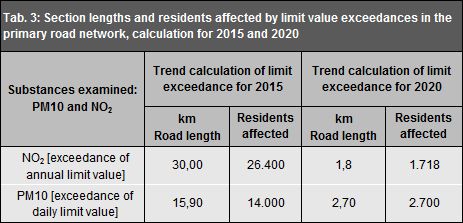For the year 2015, NO2 values above 40 µg/m3 were calculated along 215 road sections with a total length of approx. 30 km. Nearly 26,400 people live along these road sections.
By 2020, NO2 annual mean values above 40 µg/m3 are predicted for 13 sections with 1,718 affected persons and a total length of 1,800 metres.
The most severely polluted road sections lie along Potsdamer Straße between Lützowstraße and Kleistpark as well as along Schillstraße in Tiergarten and Schöneberg, along Leipziger Straße between Mauerstraße and Charlottenstraße, along Friedrichstraße between Dorotheenstraße and Mittelstraße as well as along Dorotheenstraße and Wilhelmstraße from the Reichstag up to Unter den Linden in Mitte.
Especially in Dorotheenstraße and Wilhelmstraße, many buses contribute significantly to the increased NO2 values. Whereas the diesel soot emissions of the Berlin buses were reduced by more than 90 % by fitting them with particulate filters, there is still potential for reducing the nitrogen oxide emissions. Retrofitting with systems for nitrogen oxide reduction of regular buses with the exhaust emission standards EURO IV and EURO V is already being carried out. Moreover, for new acquisitions, the exhaust emission standard EURO VI is mandated. It also has to be demonstrated that the intended reduction in emissions is also effective in urban traffic. First successes have already manifested at Hardenbergplatz. In 2015, the measurement station installed there measured NO2 concentrations lower than in the previous years by approx. 15 %.
Along Potsdamer Straße as well as along Schillstraße and Leipziger Straße, the motor vehicle traffic and the still rising share of diesel vehicles as well as the insufficient effectiveness of the NO2 reduction systems are mainly responsible for the increased values. It is assumed that without a change in legislation or tax subsidies, the proportion of diesel vehicles in Berlin will be above 50% in 2020. In that case, only a decrease in traffic volume and a significant reduction of the proportion of trucks would lead to compliance with the NO2 limits in 2020.
The current discussion about the exhaust values during the actual operation of the newest diesel vehicles also shows that these modelling results are still associated with a significant uncertainty. The Federal Environment Agency is therefore working on a further update of the manual for motor vehicle emission factors, which draws on considerably more information on the emission behaviour during actual operation particularly of diesel cars and light trucks.
Summary
It has turned out that the Berlin NO2 pollution in residential areas and along primary roads did not decrease as much as had been predicted with model calculations. The reasons for this include the significantly higher emissions of new diesel vehicles with the Euro 5 and 6 norms during actual operation. They not only lie far above the limit of the respective Euro norm to be adhered to in the laboratory but also significantly exceed the emission factors of Version 3.1 of the UBA manual that the calculations in 2009 were based on. In the meantime, the manual has been updated based on new information about the actual emissions particularly of vehicles with the exhaust emission standards Euro 5 and Euro 6, which are significantly higher than predicted in 2009. Based on these improved emission factors and newer insights into Berlin’s fleet composition, the calculation of the NO2 pollution along Berlin’s primary roads was repeated for the years 2015 and 2020.
Moreover, the NO2 background values predicted for 2009 and 2015 were adapted to the actually measured values and extrapolated to 2020.
The numbers of residents affected by NO2 limit value exceedances in 2015 and 2020 have also been corrected based on the new calculations. Whereas in 2009 it was predicted that in 2015 approx. 11,400 Berlin residents would be affected by NO2 limit value exceedances and that in 2020 no more residents would be affected, the newer calculations have shown that in 2015 approx. 26,400 and in 2020 approx. 1,700 Berliners will still be exposed to excessive NO2 pollution.

